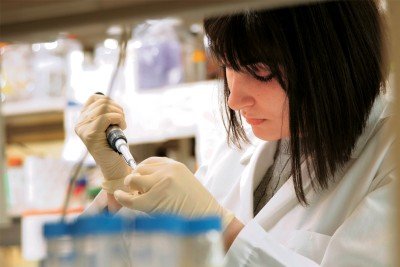
On January 13, Armine Matevossian, a first-year student at the Gerstner Sloan Kettering Graduate School of Biomedical Sciences, was already in the second week of her second laboratory rotation. Arriving in New York at the end of July, Ms. Matevossian did her first five-week rotation in the Sloan Kettering Institute laboratory of immunologist Lisa K. Denzin. By this midwinter morning, she was working in the laboratory of physician-scientist Stephen D. Nimer, Chief of Memorial Sloan Kettering Cancer Center’s Hematology Service. “This is an incredible place to learn and to work,” remarked Ms. Matevossian as she prepared an experiment. Arrayed on the lab bench before her were two pipettes, a lab notebook, and a red plastic bucket in which an army of tiny vials were staked in shaved ice. “The school has totally exceeded my expectations — and I had lots of expectations!” she continued, moving to a laboratory refrigerator to remove a box of reagents.
The Louis V. Gerstner, Jr. Graduate School of Biomedical Sciences is one of a number of Memorial Sloan Kettering Cancer Center programs that train graduate students for careers in science and medicine. It enrolled its first class in 2006. As of January, Gerstner Sloan Kettering had a total of 28 students in three classes. Approximately 240 applications were received for the fourth class, and 42 students were interviewed for ten to 12 available places. The school offers a unique program of study integrating Memorial Sloan Kettering’s basic science and clinical arms. The first-year curriculum includes course work focusing on the critical analysis of research papers, a core course of intensive study of a variety of scientific subjects, and three five-week laboratory rotations. In addition, first-year students shadow Memorial Sloan Kettering physicians, visiting Memorial Hospital clinics as observers. At the end of the spring semester, students choose a research mentor and begin their dissertation research.
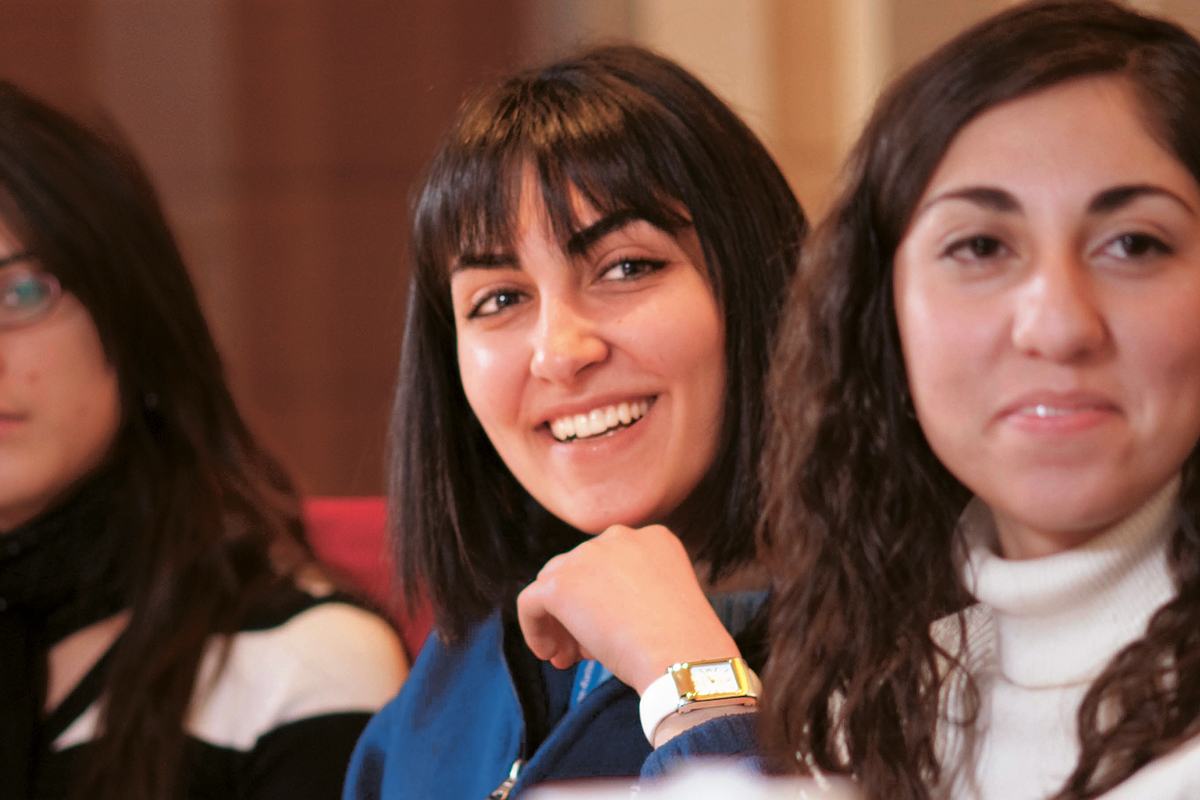
In the second year, students choose a clinical mentor. “A student’s choice of a clinical mentor is guided by his or her thesis project and is based on what they’re doing in the lab and the interests of the mentors,” explained Kenneth J. Marians, Dean of the Gerstner Sloan Kettering Graduate School and Chair of Sloan Kettering Institute’s Molecular Biology Program. “A major goal of Gerstner Sloan Kettering is to narrow the gap between basic research and clinical applications. So although the disease at Memorial Sloan Kettering is cancer, the fundamental principles of human physiology are the same. What the students learn in their clinical apprenticeships they’ll be able to apply as they think about any human disease.”
Ms. Matevossian was born in Armenia and immigrated with her family to Massachusetts when she was ten. A graduate of the University of Massachusetts Amherst, Ms. Matevossian recalled her three-day admissions visit to the Center. “What really won me over was seeing the students interacting with the faculty,” she said. “The Gerstner Sloan Kettering faculty is composed of scientists and physicians who are all leaders in their fields. Yet nowhere else I visited did I see the genuine collegiality between students and faculty that I saw here.” She also observed that because each class is small, students receive a great deal of personal attention. “Can I use the word ’homey’?” Ms. Matevossian asked, laughing. “Well, there’s certainly no huge bureaucracy — and from the classroom to the lab, I feel I can ask virtually anyone for guidance and they’re happy to provide it.”
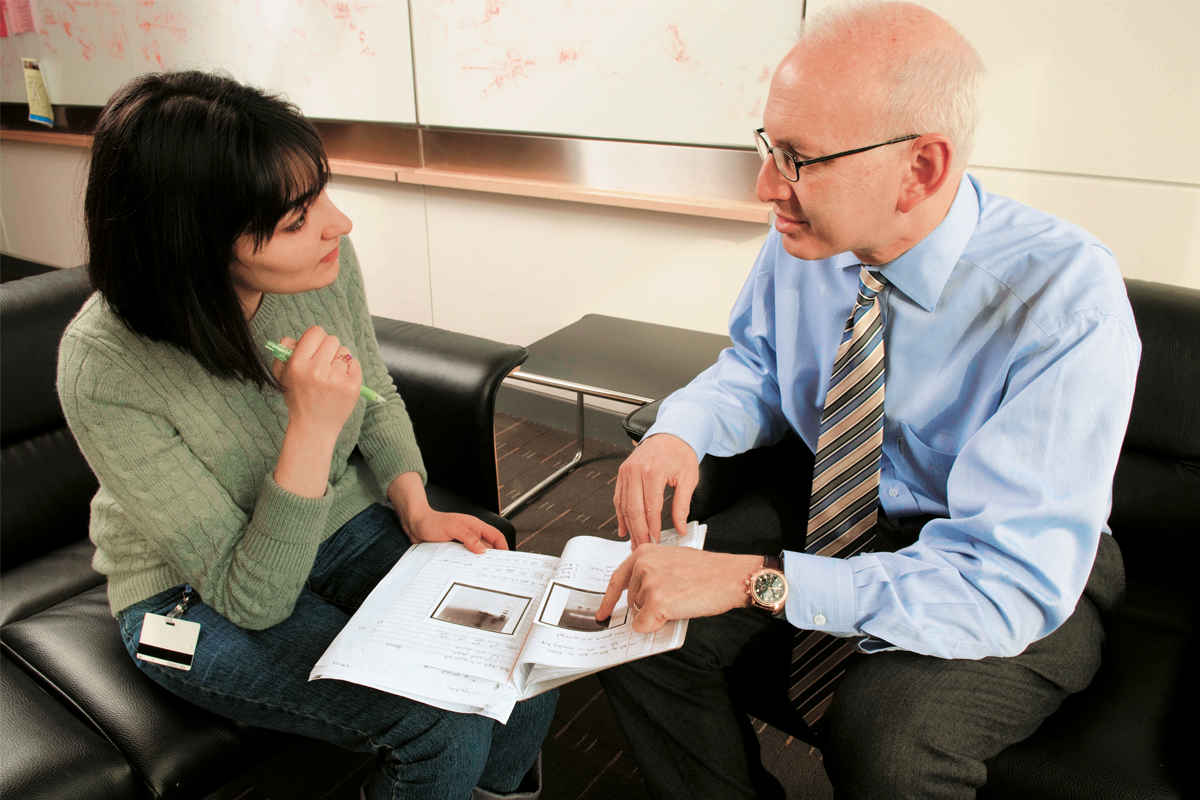
At that moment, as if on cue, Dr. Nimer entered his laboratory. On a break from seeing patients, he had come to check on the progress of various projects with lab members and to meet with Ms. Matevossian. They went to the lounge outside the laboratory where they discussed one of the experiments on which Ms. Matevossian was working, studying the levels and modification state of a protein that may be important in leukemia. When she reported a problem in obtaining the results she expected, Dr. Nimer guided her back to the beginning. “Let’s start troubleshooting,” he said. “Well,” Ms. Matevossian replied, consulting her lab notes, “the DNA is fine.” “How do you know?” Dr. Nimer countered. “How do you even know if it’s human DNA? Sometimes you ask a company to send you something and it’s not what you think it is. Maybe you’re working with mouse DNA.” He smiled. “What you learn in science is what Ronald Reagan said: ’Trust but verify.’”
Then, for more than a half hour, Dr. Nimer and Ms. Matevossian worked through a range of scenarios to try to determine what might be going awry. Later she elaborated, “The faculty wants us to understand every step of the scientific process. ’What is this assay doing?’ ’What can a false positive indicate?’ They’re really teaching us to think like scientists.”
That afternoon, Ms. Matevossian and her first-year classmates attended their journal club. Every week, first-year students read and discuss papers by — and meet with — distinguished scientists who present their work as part of the weekly President’s Research Seminar Series, which is open to the entire Memorial Sloan Kettering community. Today, the discussion was led by Sloan Kettering Institute’s Cell Biology Program Chair Alan Hall, and the paper under consideration was by cell biologist Randy W. Schekman of the University of California, Berkeley. The conversation between Dr. Hall and the students was relaxed, animated, and even punctuated by laughter, as when the discussion turned briefly to RING, an acronym for Really Interesting New Gene.
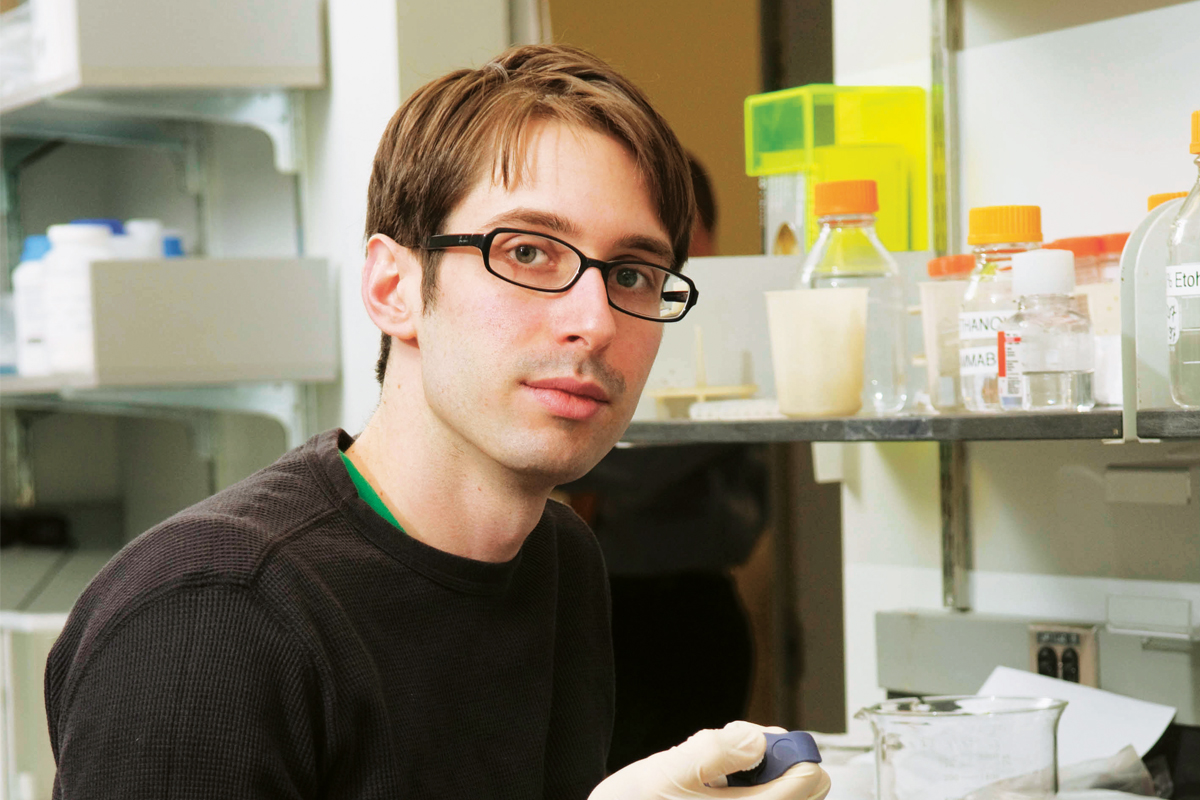
Reminiscent of the bar in the television show Cheers, “where everybody knows your name,” third-year student John Maciejowski noted of the large Gerstner Sloan Kettering faculty, “They all know who we are.” This familiarity and sense of community was evident when Mr. Maciejowski and his third-year classmate James Mahaffey, having a beer in the Student-Faculty Club the day after Ms. Matevossian’s journal club, were joined by Drs. Hall and Schekman, fresh from Dr. Schekman’s talk. They sat down with the students, and a lively conversation ensued. Mr. Maciejowski chuckled, recalling, “Jamie and Dr. Schekman are approaching a similar problem from different angles and so Jamie kind of lectured him about these proteins he’s been working on for the past two years!”
Mr. Maciejowski, a Bronx native, received his undergraduate degree from New York University. When he applied to Gerstner Sloan Kettering, he recognized he would be a member of the founding class. “I found the newness exciting,” he remarked, as he began setting up his morning’s experiments in the laboratory of molecular biologist Prasad V. Jallepalli. Dr. Jallepalli is Mr. Maciejowski’s thesis advisor.
As he worked, Mr. Maciejowski explained his dissertation research. “Most cancer cells contain an abnormal number of chromosomes, a condition known as aneuploidy,” he said. “The high frequency of aneuploidy suggests that it plays a prominent role in tumor development and implies a cancer-specific defect in the cell-cycle machinery that recognizes and corrects errors in chromosome segregation. I’m using techniques developed in the Jallepalli lab, such as gene deletion, to better understand the cell-cycle machinery that prevents aneuploidy.”
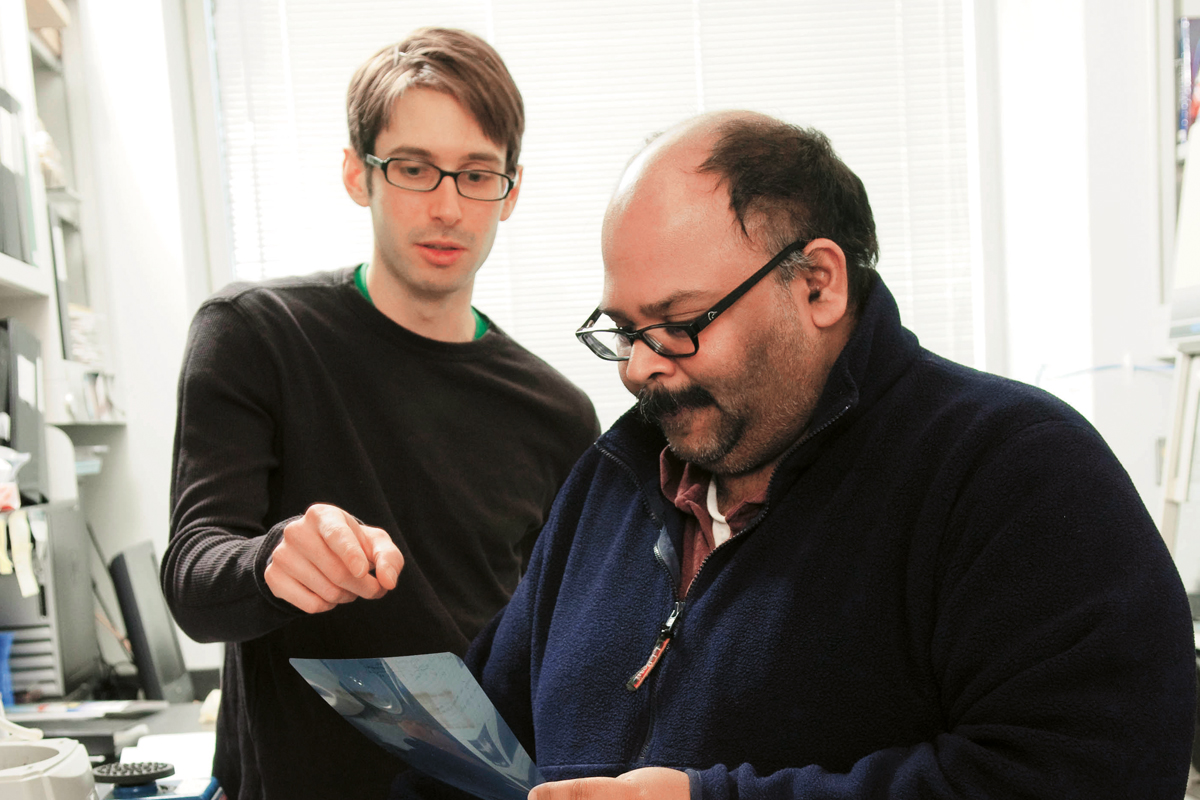
By 11 o’clock that same morning Mr. Maciejowski was trying to depart the laboratory to get to a lecture titled Assembly of the Mitotic Spindle Matrix: A Template for Coupling Cell Division and Cell Fate Choices? “But first I have to get myself away from this centrifuge!” he exclaimed, completing a task. Moments later, hurrying to the elevator, he was joined by several classmates on their way to the same lecture. At two o’clock, Mr. Maciejowski led the discussion in his journal club about a paper that reported on using time-lapse light microscopy to understand how tumor cells respond to drugs that disrupt cell division. He then returned to the laboratory. He visits the lab on weekends too, as his experiments usually require that he attend to them every day.
The following evening, Mr. Maciejowski and Ms. Matevossian joined their fellow students at a meeting of the Gerstner Sloan Kettering Student Council. A charter and bylaws were drafted by third-year students James Dowdle and Eric Alonzo, and the first meeting was convened in October 2008. The fledging council exists to provide a voice on behalf of the growing student body. “We also exist to foster a sense of community among the students,” said Mr. Dowdle, “and to work with the Gerstner Sloan Kettering leadership to help maintain the highest academic standards.”
On this night, numerous subjects were on the table — and one of the most fervently discussed was the work of the Outreach Committee. Established by the Gerstner Sloan Kettering students as a way to contribute to the enhancement of science education in the New York City public schools, they are eager to give lectures on basic cancer biology and to conduct experiments that teach the principles of laboratory science to high school students.
After the meeting concluded, when asked his impressions of his first three years at Gerstner Sloan Kettering, Mr. Maciejowski replied, “Well, I wouldn’t say I’m overwhelmed — overstimulated perhaps — but not overwhelmed!”


